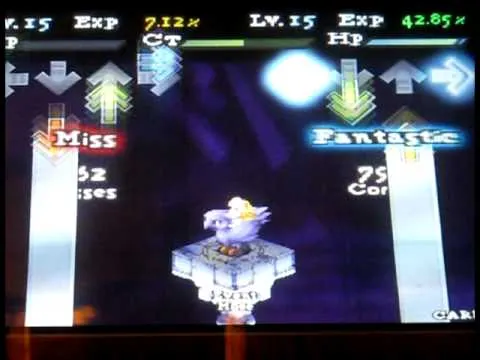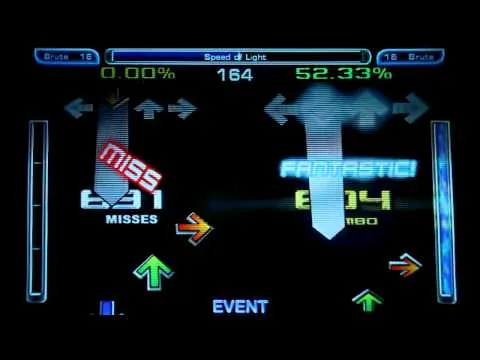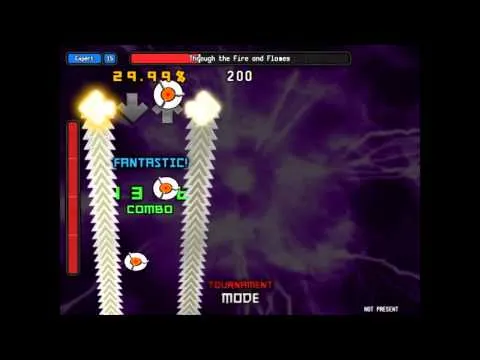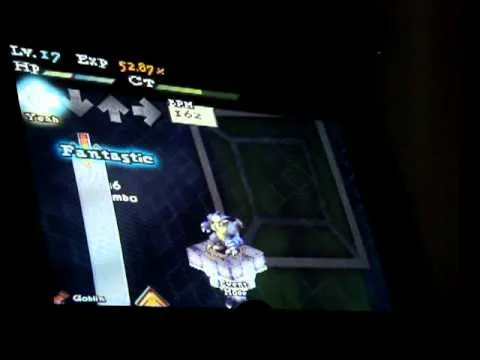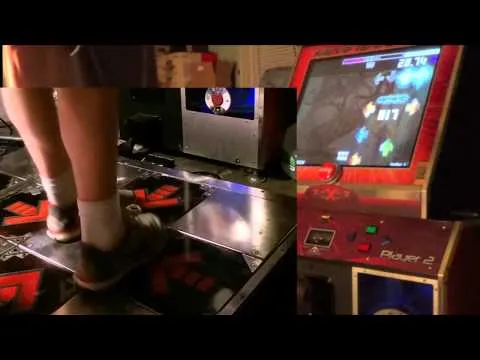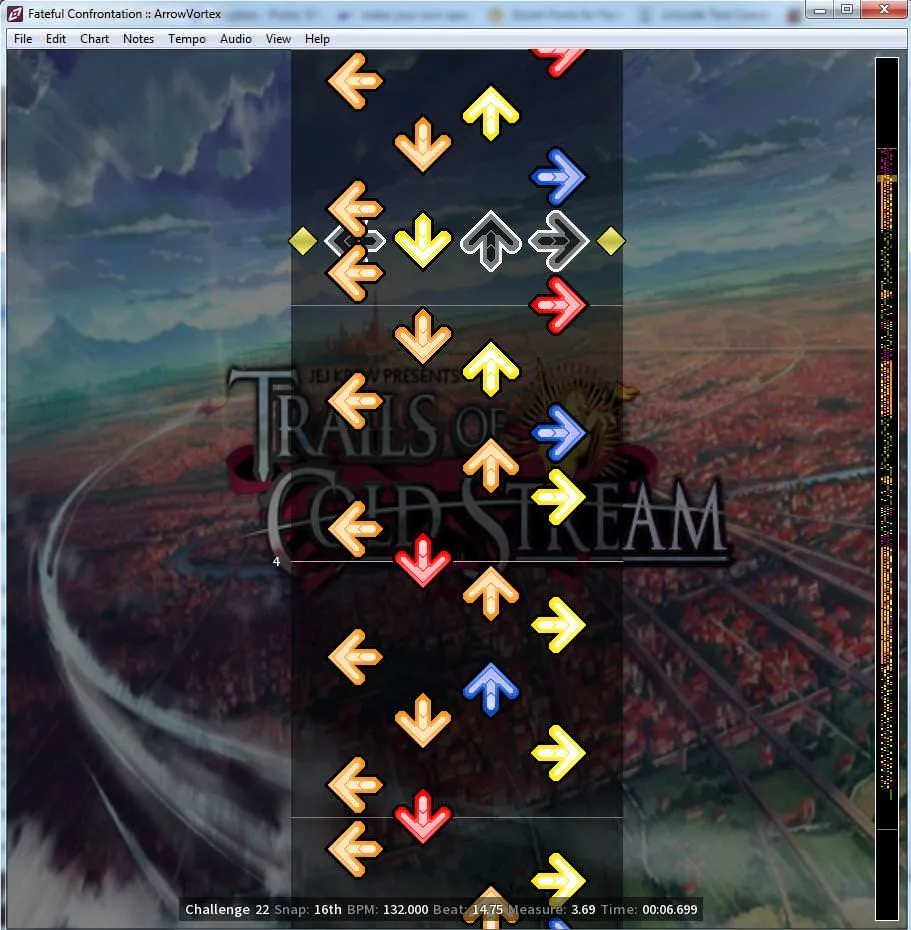
Stream stepartists:
MAD MATT
Matt, who stepped primarily for playability, modeled his patterning after what felt good, and especially during Tachyon Beta he had some really good executions in some songs that I really fell in love with. The most notable two are the candle 8ths in To Make the End of Battle (M61-69) and Necrofantasia Hellion Mix (M85-93). TMTEOB was the specific chart that taught me how to incorporate candles to scale a pattern and to accentuate intensity, and Necrofantasia taught me the power of layering in three dimensions with the growing and shrinking hold effect in the 16ths. Speed of Light helped teach me how to step 16ths to the music, and in this chart from Tachyon Alpha, the 16ths turn every couple of measures and the directional changes are fitted to the music.
To Make the End of Battle:
Necrofantasia Hellion Mix:
Speed of Light (she has vaginal bleeding):
THE COSMIC POPE
Pope's DRAGONFORCE series showed me two crucial things. The first was at macrocosmic level of the simfile pack: DRAGONFORCE was a single-artist, single-difficulty pack all with similarly-paced and rated songs. Packs with similar themes and similar musical styles and aesthetics got picked more and got played more. It was easy, right? If you were familiar with TTFAF, and that was a 7 minute 15, then it was easy to hover over Inside the Winter Storm and see from the song length and step count that it was a similarly-paced and similarly-difficult 15, and by hovering over Black Winter Night I could see that was a more difficult 15. As simfiles themselves, DRAGONFORCE taught me the power of pacing and how to step with consistency. Anyone who has played a DRAGONFORCE simfile knows their pacing: eighths, step-step-triplet step-step-triplet, triplet-triplet-triplets in the pre-chorus, 16th streams for the main chorus and 16th boxes on the drum rolls, always on measure 8 of 8. And yet, it was this consistent across every single one. You'd played one, you'd played them all, but even in spite of that, that didn't stop anyone from playing them. Nobody got bored playing a DRAGONFORCE. This was a fundamental principle that I took with me directly into my first pack and have kept ever since. I group all my content by either artist or BPM and musical styles are always similar.
Through the Fire and Flames (shoutouts the one with the SONIC background):
ARVIN
Arvin's two packs Rhapsody of Fire and Fast Track weren't so directly influential, as they each sort of existed in the shadow of DRAGONFORCE and Tachyon, but they each featured different perspectives on simfile writing that taught me how important the subjective eye of the player is. Rhapsody were similar to DRAGONFORCE but they weren't the same. One could be excused of taking a look at it and brushing it off as an attempt to cash in on the success of power metal stamina simfiles, but in the case of Rhapsody, the music isn't as structured, and the bpms are more diverse. Thus, playing Rhapsody alot showed me how, in spite of the similar structure of the music, it was possible to generate various aesthetics across simfiles that were superficially similar but, through the power of the writing, could be one kind of simfile or another. 14s like Emerald Sword were stamina-oriented, with its difficulty stemming from the amount of stream it had, but a different 14 like Steelgods of the Last Apocalypse had the 24ths at the end, which turned it into sort of a speed-oriented simfile. Despite being the same type of music and having a similar structure, minor changes in the steps could concentrate difficulty in different areas. It seems obvious now but when you're new and still navigating your way around how stuff is built and what effect it's meant to have, this kind of thing is revolutionary. Fast Track built on that by being much more mixed musically and as simfiles; but the one thing I learned the most from a simfile in this pack was how patterning mattered more and more as the BPM continued to increase. Most notably, in Level 7. What stood out the most about this chart was actually a slightly more advanced writing method that I don't Arvin actually even realizes he did. This was the playability of patterns seen as relative to the patterns around them. The interesting thing about Level 7 is that there are random parts in the stream that use two consecutive candles. On their own, chained candles at 240 bpm should be difficult, but in here, they were not. Why? What I discovered was that they felt easy to hit because the patterns around them were easier and thus less tiring. This greatly expanded on my concept of scaling that is absolutely critical to my writing today. Streams didn't have to be all one type of pattern, and different patterns meant different feelings (at the most primal level, easy patterns = feels less tiring and hard patterns = feels more tiring). I particularly want to cite Arvin specifically for his footspeed simfiles that have 24ths. Nobody else seemed to be all that good at writing 24ths and yours stood out, so naturally they became the standard I wanted to work towards.
Steelgods of the Last Apocalypse:
Level 7:
Arcane Apparatus from Beyond 24ths:
9V
Ninevolt had a pretty strong influence with -273.15. I think at the time I first saw it, it was the first real stamina 17 that I knew of where its difficulty was tilted more in favor of its 16ths. Although 170 was not really a high bpm, I understood from this simfile that candles really do add difficulty, and lots of them in large clusters added A LOT more than it may seem. Again, this built on my prevailing research throughout 2010 into how candles generally added difficulty and could be used to accent sounds in music, and this was the first time I sort of felt vindicated in that regard, like "here it is, this simfile is doing all that stuff I spent the last several months thinking about".
ARCHI
The biggest later influence really had to be Ian, because he was creating the exact kind of content that I wanted to be making: structured streams. I first discovered his talents through Moonearth, and the use of the hook was precisely the type of thing that I had always been wanting to do. Moonearth is an entire simfile of hooks. I say Ian's Moonearth, you know exactly what I'm talking about. Even my own Moonearths years later are tributes to his. Ian turning up a couple years later after I'd learned the fundamentals of how to produce a simfile was fantastic timing, because I suppose it was from here onwards that I started to discover more advanced things that weren't so directly related to the technical production but rather what was beyond that. I speak primarily to the idea that a simfile can have a personality. Pattern hooks in simfiles suddenly became by proxy, the identity of the simfile itself. Moonearth. Gate Openerz. The Fountain. Last Testament. Spiral. All I have to do is mention the name and a little switch is flicked in your head. You are remembering the personalities of these simfiles because of the hooks that were written into them. Sometimes this transcends itself and the pattern becomes named FOR the song that used it. Marunouchi Surviver and Spiral are the two most memorable examples of that.
@@
When Sam rolled along in the latter half of 2013, I was already somewhat established as a simfile artist. I was coming off of Sharpnel V2, I had Beast, Veyron, I had Zonda coming up, I even had Dragonforce SSJ1 and the first iteration of Tachyon All-Stars, so I thought there wasn't a whole lot more to learn, but Sam turned up with Oh Henry and this gave me the first look into the future of stamina. At the time I honestly disliked it because the breadth of artistry was becoming simplified and now stamina simfiles would become 90% stream. But, as things are, one must adapt, and from Sam I learned how to write a dumpstream. This meant writing all of that stuff I mentioned above, but with 16ths only and without the help of breaks to assist with scale and flow. This was a big deal because now we had someone who just picked a song he liked and made it a stream from start to finish (In My Life, In My Mind), and I knew I had to evolve to meet the coming demand. Little did I know that there was a chance to flex all that I'd learned just 6 months later with a project that I didn't think would be successful at all... named Cranked Pastry.
Jim can pattern footspeed well, and sometimes I need to see his work when I need assistance stepping speed. I have a habit of falling to my stamina patterning, which is a different beast to speed patterning, and looking at his less-structured work actually helps pull me into line when I'm writing something of that nature. Modern Arvin is in the same boat, especially with Fateful Confrontation from ToCS1, which as you know, is a very direct influence on how I've written Crimson Fighter for ToCS2.
Fateful Confrontation:
H.A.R.D.C.O.R.E:

